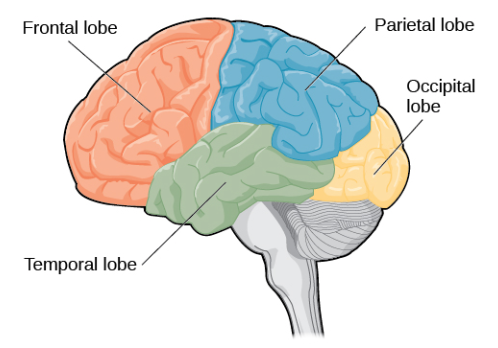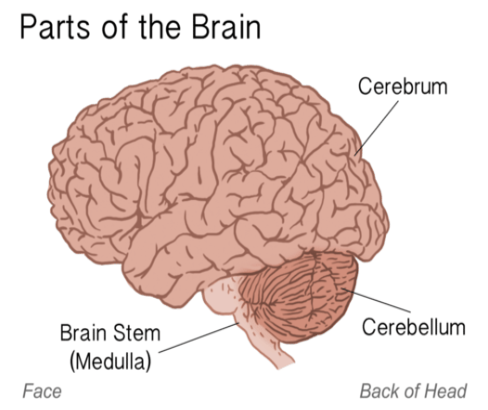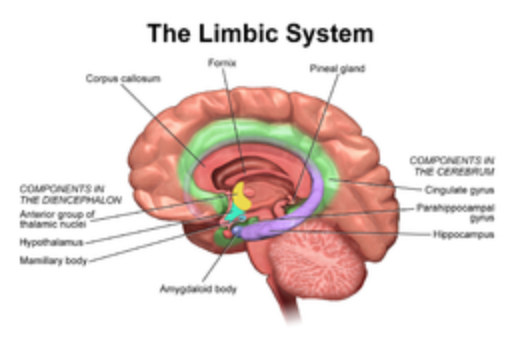April 23, 2020
Your Brain is What Makes You, You

Written by Head for the Cure Ambassador and Survivor Anna Blackwell
At the control center of the human body is the brain. A three-pound organ that controls movement, receives information through the five senses (sight, smell, touch, taste, hearing), and makes up the mind and soul of every human being.
The brain can be anatomically broken down into three parts – the cerebrum, the cerebellum, and the brainstem. The cerebrum is the largest part of the brain that interprets the five senses, as well as reasoning, emotions, learning, and fine motor skills. The cerebellum is located under the cerebrum and coordinates more ‘basic’ motor skills such as posture, balance, and muscle movements. The brainstem connects the cerebrum and cerebellum to the spinal cord, and performs numerous functions such as heart rate, breathing, body temperature, sleep cycles, digestion, sneezing, coughing, etc.

The Cerebrum
The cerebrum is divided into two hemispheres – the right and left – and are connected by corpus callosum, tiny fibers that send messages from one side to the other. The hemispheres control the opposite sides of the body, so the left hemisphere controls the right side, and vis versa. However, the left and right hemispheres are not identical in function. The left hemisphere controls writing, comprehension, speech, and mathematical processing, whereas the right controls creativity, spatial ability, and artistic/musical skills.
Not only is the cerebrum divided into hemispheres, but it is also divided into 4 distinct lobes – the frontal, parietal, occipital, and temporal. The frontal lobe is located at – you guessed it – the front of the brain. This lobe is primarily responsible for personality, behavior, and emotions, and is dominant in judgement, planning, and problem solving, as well as body movement, speech, self-awareness, and speech. In short, the frontal lobe is the control center for what makes you, you.
Located under the frontal lobe is the temporal. The temporal lobe is responsible for understanding language, hearing, memory, and sequencing/organization. Think of the temporal lobe like a filing cabinet. It stores memories in one file, and audio in another.
The parietal lobe takes the audio stored by the temporal lobe and interprets the memories, words and general language. Additionally, this lobe is responsible for sensory, like temperature, pain and touch, and spatial/visual perception. Another key role of the parietal lobe is the interpretation of signals that are sent from the occipital lobe, which interprets vision in the form of color, light, and movement.

The Deep Structures of the Brain
In addition to the basic four lobes and two hemispheres, there are six major ‘deep structures’ of the brain that help to maintain homeostasis (the “just-right” zone for the body). These structures include the hypothalamus, pituitary gland, pineal gland, thalamus, basal ganglia, and limbic system. The hypothalamus is responsible for controlling hunger, thirst, sleep, and regulates body temperature, blood pressure, hormones, and emotions. The pituitary gland is connected to the hypothalamus by a pituitary stalk, and controls other glands that help to secrete hormones. The pineal gland is responsible for regulating the body’s internal clock, as well as providing aid in sexual development. The thalamus is responsible for interpreting pain and memory, as well as attention and alertness. The basal ganglia works with the cerebellum (the part of the brain under the cerebrum) to coordinate fine motor skills. Finally, the limbic system is the head of our emotions, learning, and memory.

What Coordinates with the Brain?
Not only does the brain coordinate with the body through the spinal cord, but it also sends signals through the twelve pairs of cranial nerves. Represented by Roman numerals, the twelve pairs are listed below with their general function.
| Roman numeral | Name | Function |
| I | Olfactory | Smell |
| II | Optic | Sight |
| III | Oculomotor | Moves eye |
| IV | Trochlear | Moves eye |
| V | Trigeminal | Face sensation |
| VI | Abducens | Move eye |
| VII | Facial | Moves face |
| VIII | Vestibulocochlear | Hearing, balance |
| IX | Glossopharyngeal | Taste, swallow |
| X | Vagus | Heart rate, digestion |
| XI | Accessory | Moves head |
| XII | Hypoglossal | Moves tongue |
Wrap Up
The complex three-pound organ known as the brain controls how we function, how we walk, talk, and sleep, even who we are as people. 86 billion neurons, 4 lobes, 2 hemispheres, 6 deep structures, 12 pairs of cranial nerves that make us, us.